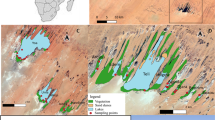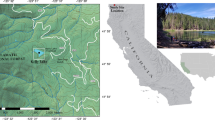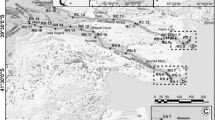Abstract
Different calibration methods and data manipulations are being employed for quantitative paleoenvironmental reconstructions, but are rarely compared using the same data. Here, we compare several diatom-based models [weighted averaging (WA), weighted averaging with tolerance-downweighting (WAT), weighted averaging partial least squares, artificial neural networks (ANN) and Gaussian logit regression (GLR)] in different situations of data manipulation. We tested whether log-transformation of environmental gradients and square-root transformation of species data improved the predictive abilities and the reconstruction capabilities of the different calibration methods and discussed them in regard to species response models along environmental gradients. Using a calibration data set from New England, we showed that all methods adequately modelled the variables pH, alkalinity and total phosphorus (TP), as indicated by similar root mean square errors of prediction. However, WAT had lower performance statistics than simple WA and showed some unusual values in reconstruction, but setting a minimum tolerance for the modern species, such as available in the new computer program C2 version 1.4, resolved these problems. Validation with the instrumental record from Walden Pond (Massachusetts, USA) showed that WA and WAT reconstructed most closely pH and that GLR reconstructions showed the best agreement with measured alkalinity, whereas ANN and GLR models were superior in reconstructing the secondary gradient variable TP. Log-transformation of environmental gradients improved model performance for alkalinity, but not much for TP. While square-root transformation of species data improved the performance of the ANN models, they did not affect the WA models. Untransformed species data resulted in better accordance of the TP inferences with the instrumental record using WA, indicating that, in some cases, ecological information encoded in the modern and fossil species data might be lost by square-root transformation. Thus it may be useful to consider different species data transformations for different environmental reconstructions. This study showed that the tested methods are equally suitable for the reconstruction of parameters that mainly control the diatom assemblages, but that ANN and GLR may be superior in modelling a secondary gradient variable. For example, ANN and GLR may be advantageous for modelling lake nutrient levels in North America, where TP gradients are relatively short.
Similar content being viewed by others
References
Baystate Environmental Consultants I, 1995. Study of trophic level conditions of Walden Pond, Concord, Massachusetts. Commonwealth of Massachusetts, Department of Environmental Management, Division of Resource Conservation. East Longmeadow, 111 pp.
Birks H.J.B. 1994. The importance of pollen and diatom taxonomic precision in quantitative palaeoenvironmental reconstructions. Rev. Palaeobot. Palynol. 83: 107–117.
Birks H.J.B. 1995. Quantitative paleoenvironmental reconstructions. In: Maddy D. and Brew J.S. (eds), Statistical Modelling of Quaternary Science Data. Quaternary Research Association, Cambridge, pp. 161–254.
Birks H.J.B. 1998. Numerical tools in paleolimnology - progress, potentialities, and problems. J. Paleolim. 20: 307–332.
Birks H.J.B., Line J.M., Juggins S., Stevenson A.C. and ter Braak C.J.F. 1990. Diatoms and pH reconstruction. Philos. T. Roy. Soc. B 327: 263–278.
BonéR., Cruciano M. and Asselin de Beauville J.-P. 1998. Yet Another Neural Network Simulator. Proceedings of the conference Neural Networks and their Applications (NEURAP' 98), Marseilles, France, 421–424.
Cameron N.G., Birks H.J.B., Jones V.J., Berge F., Catalan J., Flower R.J., Garcia J., Kawecka B., Koinig K.A., Marchetto A., Sanchez-Castillo P., Schmidt R., Sisko M., Solovieva N., Stefkova E. and Toro M. 1999. Surface-sediment and epilithic diatom pH calibration sets for remote European mountain lakes (AL: PE Project) and their comparison with the Surface Waters Acidification Programme (SWAP) calibration set. J. Paleolim. 22: 291–317.
Colman J.A. and Friesz P.J. 2001. Geohydrology and Limnology of Walden Pond, Concord, Massachusetts. U.S. Geological Survey. Northborough, Massachusetts, Water-Resources Investigations Report, 61 pp.
Dixit S.S., Smol J.P., Charles D.F., Hughes R.M., Paulsen S.G. and Collins G.B. 1999. Assessing water quality changes in the lakes of the northeastern United States using sediment diatoms. Can. J. Fish. Aquat. Sci. 56: 131–152.
Hall R.I. and Smol J.P. 1992. A weighted-averaging regression and calibration model for inferring total phosphorus concentration from diatoms in British Columbia. Freshwat. Biol. 27: 417–437.
Hall R.I. and Smol J.P. 1996. Paleolimnological assessment of long-term water-quality changes in south-central Ontario lakes affected by cottage development and acidification. Can. J. Fish. Aquat. Sci. 53: 1–17.
Hall R.I., Leavitt P.R., Smol J.P. and Zirnhelt N. 1997. Comparison of diatoms, fossil pigments and historical records as measures of lake eutrophication. Freshwat. Biol. 38: 401–417.
Huisman J., Olff H. and Fresco L.F.M. 1993. A hierarchical set of models for species response analysis. J. Vegetation Sci. 4: 37–46.
Juggins S. 2003. C User Guide. Software for Ecological and Paleoecological Data Analysis and Visualisation. University of Newcastle, Newcastle upon Tyne, UK, 69 pp.
Kauppila T., Moisio T. and Salonen V.P. 2002. A diatom-based inference model for autumn epilimnetic total phosphorus concentration and its application to a presently eutrophic boreal lake. J. Paleolim. 27: 261–273.
Korsman T. and Birks H.J.B. 1996. Diatom-based water chemistry reconstructions from northern Sweden: a comparison of reconstruction techniques. J. Paleolim. 15: 65–77.
Laing T.E., Rühland K. and Smol J.P. 1999. Past environmental and climatic changes related to tree-line shifts inferred from fossil diatoms from a lake near the Lena River Delta, Siberia. Holocene 9: 547–557.
Lotter A.F., Birks H.J.B., Hofmann W. and Marchetto A. 1998. Modern diatom, cladocera, chironomid, and chrysophyte cyst assemblages as quantitative indicators for the reconstruction of past environmental conditions in the Alps. II. Nutrients. J. Paleolim. 19: 443–463.
Oksanen J. and Minchin P.R. 2002. Continuum theory revisited: what shape are species responses along ecological gradients? Ecol. Model. 157: 119–129.
Overpeck J.T., Webb T. and Prentice I.C. 1985. Quantitative interpretation of fossil pollen spectra: dissimilarity coefficients and the method of Modern Analogs. Quat. Res. 23: 87–108.
Racca J.M.J. and Prairie Y.T. 2004. Apparent and real bias in numerical transfer functions in paleolimnology. J. Paleolim. 31: 117–124.
Racca J.M.J., Philibert A., Racca R. and Prairie Y. 2001. A comparison between diatom-based inference models using Artificial Neural Networks (ANN), Weighted Averaging (WA) and Weighted Averaging Partial Least Squares (WA-PLS). J. Paleolim. 26: 411–422.
Ramstack J.M., Fritz S.C., Engstrom D.R. and Heiskary S.A. 2003. The application of a diatom-based transfer function to evaluate regional water-quality trends in Minnesota since 1970. J. Paleolim. 29: 79–94.
Siver P.A. 1999. Development of paleolimnologic inference models for pH, total nitrogen and specific conductivity based on planktonic diatoms. J. Paleolim. 21: 45–59.
Siver P.A., Ricard R., Goodwin R. and Giblin A.E. 2003. Estimating historical in-lake alkalinity generation from sulfate reduction and its relationship to lake chemistry as inferred from algal microfossils. J. Paleolim. 29: 179–197.
ter Braak C.J.F. 1995. Nonlinear methods for multivariate statistical calibration and their use in palaeoecology - a comparison of inverse (k-nearest neighbors, partial least-squares and weighted averaging partial least-squares) and classical approaches. Chemometrics Intell. Lab. Syst. 28: 165–180.
ter Braak C.J.F. and van Dam H. 1989. Inferring pH from diatoms: a comparison of old and new calibration methods. Hydrobiologia 178: 209–223.
ter Braak C.J.F. and Juggins S. 1993. Weighted averaging partial least squares regression (WA-PLS): an improved method for reconstructing environmental variables from species assemblages. Hydrobiologia 269/270: 485–502.
Wilson S.E., Cumming B.F. and Smol J.P. 1996. Assessing the reliability of salinity inference models from diatom assemblages: an examination of a 219-lake data set from western North America. Can. J. Fish. Aquat. Sci. 53: 1580–1594.
Author information
Authors and Affiliations
Rights and permissions
About this article
Cite this article
Köster, D., Racca, J.M.J. & Pienitz, R. Diatom-based inference models and reconstructions revisited: methods and transformations. Journal of Paleolimnology 32, 233–246 (2004). https://doi.org/10.1023/B:JOPL.0000042907.90500.5a
Issue Date:
DOI: https://doi.org/10.1023/B:JOPL.0000042907.90500.5a




